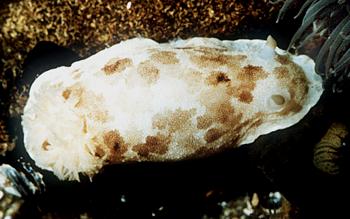
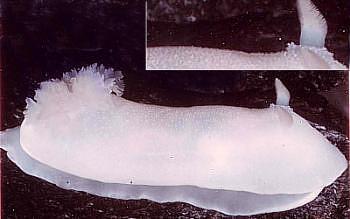
Diaulula lentiginosa
Millen, 1982
Order: NUDIBRANCHIA
Suborder: DORIDINA
Superfamily: EUDORIDOIDEA
Family: Dorididae
PHOTO
Mottled and white forms. Photos: Sandra Millen.
Formerly known as Anisodoris lentiginosa. See message.
See also message suggesting it is not Diaulula.
See Sandra Millen's message below. See below for photos of other colour forms.
Reference:
• Millen, S.V. (1982). A new species of nudibranch (Opisthobranchia: Mollusca) belonging to the genus Anisodoris. Can. J. Zool, 60(11): 2694-2705
Rudman, W.B., 2000 (October 13) Diaulula lentiginosa Millen, 1982. [In] Sea Slug Forum. Australian Museum, Sydney. Available from http://www.seaslugforum.net/find/anislent
Related messages
Diaulula lentiginosa? from Carmel, California
July 5, 2005
From: Clinton Bauder
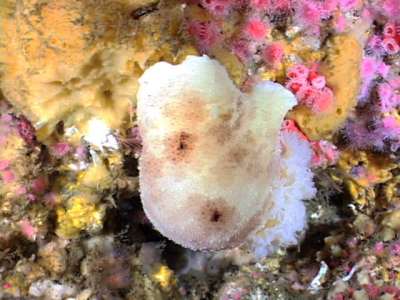
Hi Bill,
Diving off of Yankee Point in Carmel near one of our favorite offshore pinancles. We were a bit north of the area we normally dive which in this location means the reef is more exposed to the prevailing current. I saw 2 very large dorids which I suspect are Diaulula lentiginosa (Is that the correct name these days or is it still Anisodoris lentiginosa?). If this is correct it's quite a range extension. My picture isn't the best but it's enough to show that the animal really looks like the same thing as I've seen before in British Columbia. The animal in the picture is huge; 300mm or so and was at a depth of around 55 meters. The other one which I don't have an image of was shallower, maybe 40 meters. I'm not 100% sure about the sponge it appears to be eating but it might be Halichondria panicea.
Locality: Yankee Point, Carmel, California, USA. Depth: 55 meters. Length: 300 mm. 25 June 2005. Vertical rocky wall. Photographer: Clinton Bauder
Clinton
gecko1@apple.com
Bauder, C., 2005 (Jul 5) Diaulula lentiginosa? from Carmel, California. [Message in] Sea Slug Forum. Australian Museum, Sydney. Available from http://www.seaslugforum.net/find/14147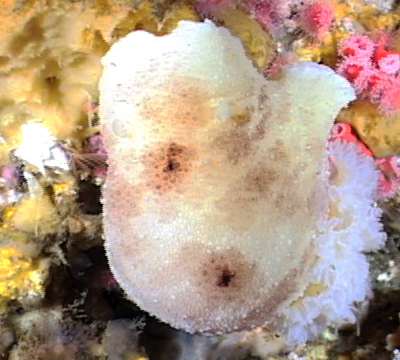
Dear Clinton,
Certainly to my untutored eye it looks like the mottled form of Diaulula lentiginosa. Concerning your comment about the generic position of this species. Basically its in a state of limbo at the moment. As I mentioned in an earlier message [#8419], Anisodoris is now considered a synonym of Diaulula. Unfortunately Anisodoris lentiginosa was not a good Anisodoris in the first place, lacking such essential features as caryophyllidia. Dave Behrens (2004) has provisionally placed it in Peltodoris, but as he says, it needs a proper investigation to be sure. Perhaps I should have left it in Anisodoris until the dust settles.
Best wishes,
Bill Rudman
Anisodoris lentiginosa? from British Columbia
August 9, 2002
From: Clinton Bauder
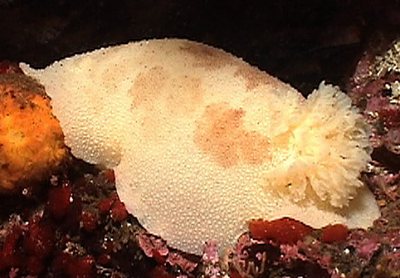
Hi Bill,
Pretty sure these pictures are of Anisodoris lentiginosa. They were shot at Bischoff Island in British Columbia, Canada, July 2002. Depth was about 18M-20M and the animal was very large. Over 200mm for sure. The very fine dark black spots on the photos are particulate matter in the water and not markings on the slug. This is more obvious from the original video than the still frames.
I have included inages of another animal, and a possible egg ribbon, from Langara Island in the Queen Charlottes (BC), in a separate message.
Clinton
gecko1@apple.com
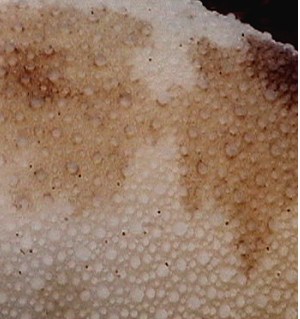
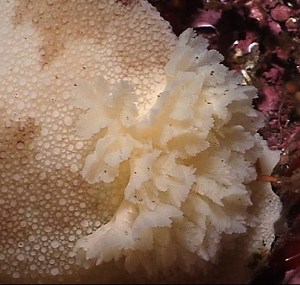
Thanks Clinton,
I look forward to some comments from local experts on the identity of these two slugs. They look like Anisodoris lentiginosa to me, but it seems wise to call on local knowledge when trying to identfy your large west coast dorids.
Cheers,
Bill Rudman
Anisodoris lentiginosa from British Columbia (2)
August 9, 2002
From: Clinton Bauder
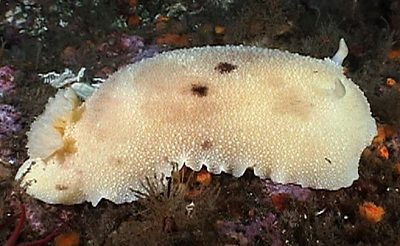
Hi Bill,
To accompany my other message here are some pictures of Anisodoris lentiginosa from Langara Island in the Queen Charlottes (British Columbia, Canada) in July 2002. Depth was about 18M-20M and the animal was very large. Over 200mm for sure.
I'm not entirely sure if the egg ribbon belongs to the slug but it seems likely.
Clinton
gecko1@apple.com
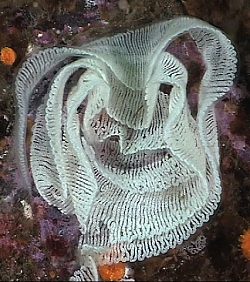
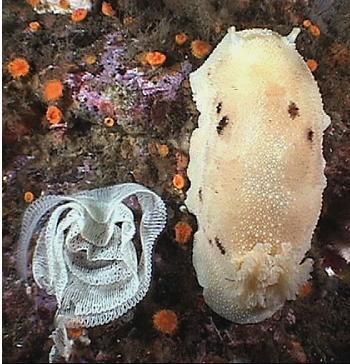
Thanks Clinton,
It will be interesting to see if anyone recognises the egg ribbon. It looks fairly distinctive. Its size and proximity certainly suggest it belongs to the slug, but we can be easily fooled.
Cheers,
Bill Rudman
More photos of Anisodoris lentiginosa
October 23, 2000
From: Clinton Bauder
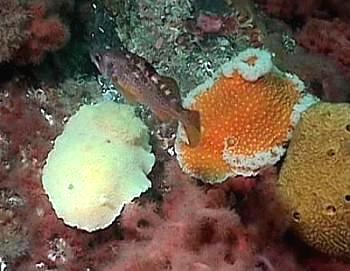
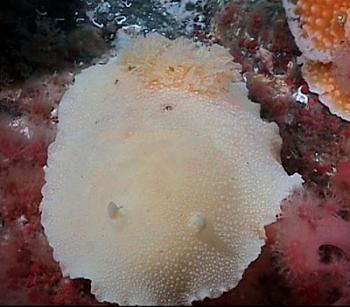
Hi Bill,
So I'm even more confused now! Two things which I forgot to mention about my British Columbia critter; first it was large - maybe 180 to 200mm long. Second, the pigment on the spot on the back does not appear to extend onto the tubercle protruding from the middle of it. Hopefully these are useful clues. The size would seem to eliminate Geitodoris heathi but not Anisodoris lentignosa. I hadn't considered the latter as the picture in Dave's book doesn't look anything like my critter but the description seems to indicate that Jeff might be right. Also the fact that the tubercle lacks pigment weighs against Archidoris montereyensis.
I've enclosed 2 more images from my video more clearly showing the size and the spot on the back.
Clinton
gecko1@apple.com
Bauder, C., 2000 (Oct 23) More photos of Anisodoris lentiginosa. [Message in] Sea Slug Forum. Australian Museum, Sydney. Available from http://www.seaslugforum.net/find/3193Dear Clinton,
Sorry it's taken a while to answer your message but I thought it was best to try and get the identity right before I posted any more 'sea lemon' pictures. Thankfully Sandra Millen has clarified things for me. If you have a look at her message you will see she is pretty sure your animal is a colour form of Anisodoris lentiginosa.
If you look carefully at your lower photo, you can see faint darker patches which I guess represent the dark patches in more typical animals.
And for those of you unfamiliar with the fauna, the red-orange animal on the right in the top photo is not a sea-lemon. It is the tritoniid Tochuina tetraquetra.
Sandra also suggests the upper right photo in your original message is of a white and yellow Geitodoris heathi rather than Archidoris montereyensis.
Best wishes,
Bill Rudman.
White and yellow sea lemons
October 23, 2000
From: Sandra Millen


Hi Bill,
Concerning your request for my views on the photos of Archidoris montereyensis, Archidoris odhneri and Anisodoris nobilis and similar looking dorids recently sent to the Forum by Jeff Goddard and Clinton Bauder, I offer the following suggestions.
Clinton's photo of two dorids, one white, one yellow is, I suspect, Geitodoris heathi rather than Archidoris montereyensis. This animal has even more extremes in color variability than Anisodoris lentiginosa. I think they are Geitodoris because they are flat and the tubercles look low and rounded - but it is very hard to tell from this photo.
Even though I described Anisodoris lentiginosa, I never saw the color pattern shown by Jeff Goddard and Clinton Bauder. Smaller animals were either pure white or creamy yellow and had no spots, larger animals had varying amounts of brown blotching, usually pale but often with a few dark areas. The spots did not cover the tubercles. I find it interesting that Jeff and Clinton's photo's show a faint light ring around the dark spots. The tubercle pattern is like that of A. lentiginosa as is the body shape in Jeff's photo. Clinton's animal looks rather flat and the rhinophores do not show the characteristic backwards slant, but both of those differences could be due to the angle of the shot. One way to tell for sure, would be to look at the penis, which has unique, broad, serrated spines. If anyone sends me a preserved sample of this presumed color variety, I'd be happy to check it out. I think this 'mystery dorid' (lower right) in size, gills and tubercles is Anisodoris lentiginosa. It is probably a color variety I havn't seen, which doesn't mean a lot because I have seen them from pure white or cream to quite mottled. I am sending you a photo of both extremes.
By the way, Anisodoris nobilis is the only one of these doruds with a distinct lemon scent. Its citrus fruit aroma is quite pleasant and usually only given off when the animal is handled. Another scented nudibranch on the west coast of North America is Melibe leonina. It has a a sweet fruity aroma which you can smell throughout the room when a number of them are in a tank. It tends to 'get to you' like a bad perfume. They are gregarious animals and probably use it to keep together.
I agree the photo on the lower left of Clinton's message is Archidoris odhneri.
Sandra
millen@zoology.ubc.ca
Millen, S., 2000 (Oct 23) White and yellow sea lemons. [Message in] Sea Slug Forum. Australian Museum, Sydney. Available from http://www.seaslugforum.net/find/3195Dear Sandra,
Thanks for your help in clarifying these dorids from the west coast of North America. I must say it all looked fairly easy when I just had Dave Behren's book to look at, but once the variations began to appear....
And thanks for the information about the citrus smell of Anisodoris nobilis. I feel much happier knowing that sea lemons get their name from the scent of one of them rather than their colour and shape.
Best wishes,
Bill Rudman.
Anisodoris lentiginosa
October 16, 2000
From: Jeff Goddard
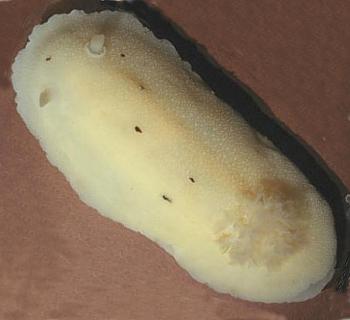
Hi Bill,
I just saw Clinton Bauder's message on Archidoris and Anisodoris. Sandra Millen will likely also respond to his message because the dorid pictured in his lower right photo is Anisodoris lentiginosa described by Sandra in 1982. It looks very similar to the two specimens I have found at Cape Arago, Oregon, which also had just a few small chocolate brown patches on the dorsum. Cape Arago is currently the southern known range limit of this species. The first time I found this species, I too thought I had found a cross between an Archidoris and Anisodoris.
The specimen pictured measured 90 mm long, and was found in the low rocky intertidal at Cape Arago, Oregon, May 1980.
The identification of the slug in my photo was made by Sandra Millen in a letter to me (18 Jan 1983) after I sent her some photos and a description of that specimen. It had a radula formula of 26(62.0.62) and even though the pigmented spots are much smaller than those pictured in Sandra's description (and Behrens), the dark pigment was BOTH between and in the dorsal papillae.
It is possible, but less likely, that Clinton's lower right photo is of an unusually light colored Geitodoris heathi, which often have a concentration of brown pigment just in front of the gills. However, I don't recall seeing specimens of G. heathi without the characteristic sprinkling of minute black flecks on the dorsum.
Best wishes,
Jeff
Goddard@lifesci.ucsb.edu
Goddard, J., 2000 (Oct 16) Anisodoris lentiginosa. [Message in] Sea Slug Forum. Australian Museum, Sydney. Available from http://www.seaslugforum.net/find/3178Thanks Jeff,
In Dave Behren's book and in Sandra Millen's description, Anisodoris lentiginosa has large patches of various shades of brown, very similar to the pattern found in the Indo-West Pacific species Discodoris lilacina. Interestingly D.lilacina ranges in colour from animals with large brown patches to others that are almost a uniform pale colour, as in your photo of A. lentiginosa. When I get a chance I will post some photos of colour variability in D. lilacina. If A. lentiginosa is so variable in colour then it is a remarkable parallel to D. lilacina.
But first, I would be glad of some further information on colour variability in Anisodoris lentiginosa.
Bill Rudman.
Rudman, W.B., 2000 (Oct 16). Comment on Anisodoris lentiginosa by Jeff Goddard. [Message in] Sea Slug Forum. Australian Museum, Sydney. Available from http://www.seaslugforum.net/find/3178